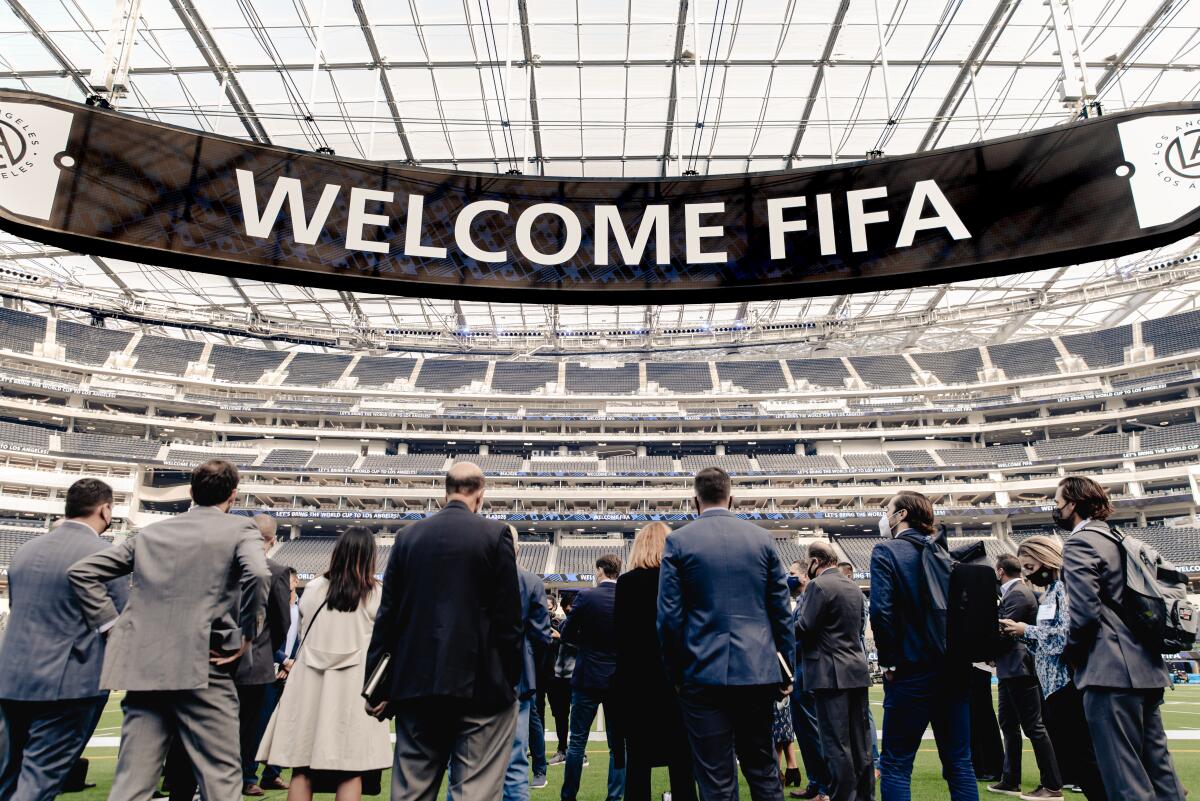SoFi Stadium and Rose Bowl are among venue finalists for 2026 World Cup matches

- Share via
FIFA will choose host cities for the 2026 World Cup from among 23 candidates in the U.S., Mexico and Canada on Thursday, setting the stage for the largest, most challenging tournament in World Cup history.
Two stadiums in Southern California — SoFi Stadium in Inglewood and the Rose Bowl in Pasadena — are among the finalists. FIFA, the world governing body for soccer, is expected to select 16 venues, as many as a dozen in the U.S.
The World Cup field is expanding to a record 48 teams and 80 games in 2026, with 60 of those games expected to be played in the U.S. and 10 each in Canada and Mexico. Canada has proposed staging games in Vancouver, Edmonton and Toronto while Mexico is offering Monterrey, Guadalajara and Mexico City’s Azteca Stadium, which has already played host to two World Cup finals.
Seventeen stadiums in the U.S. are among the finalists. SoFi Stadium, the world’s most expensive stadium at more than $5 billion, staged last February’s Super Bowl and has long been a favorite of FIFA officials despite the fact the artificial turf field is too narrow to accommodate a World Cup pitch.
The Rose Bowl, which played host to eight games in the 1994 men’s World Cup, including the final, and four games in the 1999 women’s World Cup, including the final, is also on the list.
It’s likely Southern California will be the site of multiple games, including a quarterfinal or semifinal. But the time difference between both Europe and Asia works against the World Cup final again being played here.
The other candidates:
Angel City’s Christen Press announced on social media that she has a torn ACL in her right knee and will miss the rest of the team’s inaugural NWSL season.
AT&T Stadium (Arlington, Texas): A favorite home away from home for the Mexican national team, the Dallas Cowboys’ stadium is the largest venue in the NFL with 93,000 seats. Opened in 2009, it has a retractable roof and an artificial surface.
Mercedes-Benz Stadium (Atlanta): One of three NFL-MLS venues, the 5-year-old stadium has retractable roof and an artificial surface and seats about 75,000.
M&T Bank Stadium (Baltimore): Home of the Baltimore Ravens, the stadium opened in 1998, seats about 71,000 and has a grass surface.
Paul Brown Stadium (Cincinnati): The stadium opened in 2000 and has a seating capacity of about 67,000 with an artificial surface.
Empower Field at Mile High (Denver): The city’s mile-high altitude will figure in its selection or rejection. The venue opened in 2001 and has a capacity of about 77,000 with a grass surface.
MetLife Stadium (East Rutherford, N.J.): The 12-year-old stadium, home to both the New York Jets and New York Giants, is the heavy favorite to land the World Cup final. It has a seating capacity of about 87,000 and has an artificial surface.
Gillette Stadium (Foxborough, Mass): Suburban Foxborough played host to games at the 1994 World Cup, but Gillette Stadium is a different venue. Opened in 2002, it and has a seating capacity of about 70,000.
NRG Stadium (Houston): One of two Texas stadiums on the list, NRG opened in 2002 has a seating capacity of about 72,000 and an artificial surface. Its retractable roof and air conditioning will be important given the area’s summer heat and humidity.
Megan Rapinoe, who has not started for her NWSL club this season, is among the U.S. players who will be competing at the CONCACAF W Championship.
Arrowhead Stadium (Kansas City, Mo.): The second-oldest stadium on the list, Arrowhead opened in 1972 and has been renovated several times, most recently in 2010. The seating capacity is about 76,000 and it has a grass surface.
Hard Rock Stadium (Miami Gardens, Fla.): Miami appears to be a cinch to get at least one game. The venue, which has a seating capacity of about 67,000, a grass surface and a roof that covers spectators, opened in 1987 and has been renovated multiple times. It has hosted numerous international soccer exhibitions.
Nissan Stadium (Nashville): A longshot, Nashville has playing up its cultural significance as the home of country music. The stadium, opened in 1999, staged group matches during the 2017 CONCACAF Gold Cup and has also been the venue for World Cup qualifiers. It has a capacity of about 70,000 and a grass surface.
Camping World Stadium (Orlando, Fla.): If Miami gets a game, it’s unlikely Orlando would. The market has World Cup experience since the stadium, then known as the Citrus Bowl, held matches in the 1994 World Cup. The 65,000-seat stadium opened in 1936 but has undergone several face-lifts. It has an artificial surface.
Lincoln Financial Field (Philadelphia): When the facility opened in 2003, its first event was a soccer match between Manchester United and Barcelona. The stadium serves as the home venue for the Philadelphia Eagles and Temple University. The 2015 CONCACAF Gold Cup final was played at the stadium, with Mexico beating Jamaica 3-1. The stadium seats nearly 70,000 spectators and has an artificial surface.
LAFC diverted from its strategy of signing young South American talent and supporting them with MLS veterans by signing Giorgio Chiellini. Why it works.
Levi’s Stadium (Santa Clara, Calif.): Opened in 2014, the stadium has played host to a Super Bowl and several major soccer games. It has a capacity of about 71,000 and a grass surface.
Lumen Field (Seattle): Home to the NFL’s Seahawks, the OL Reign of NWSL and the Sounders of MLS, the stadium opened in 2002 and has a capacity of about 69,000.











